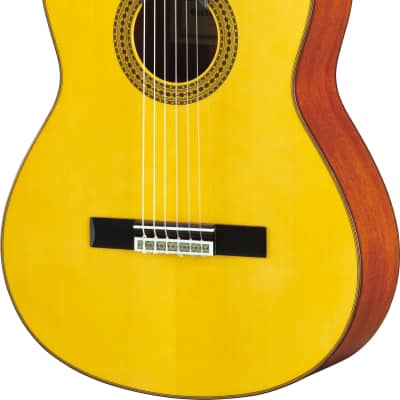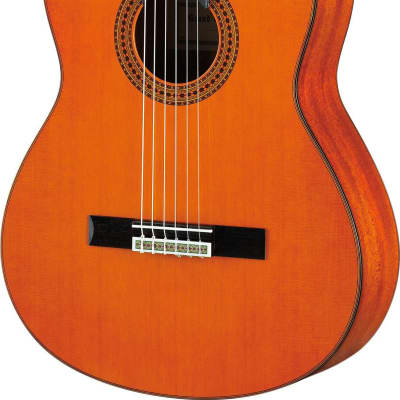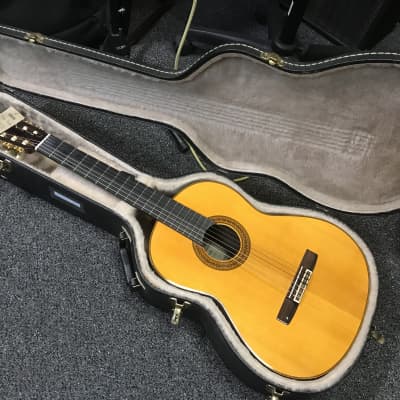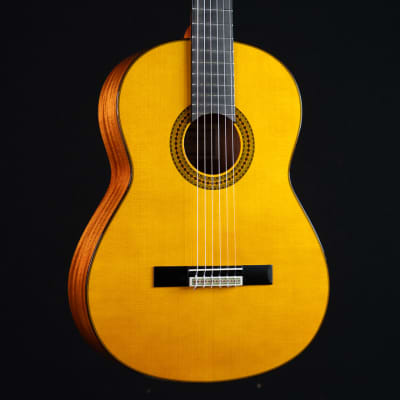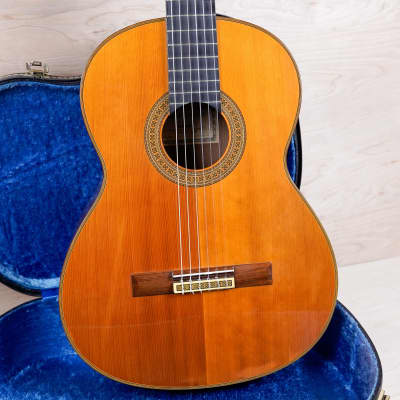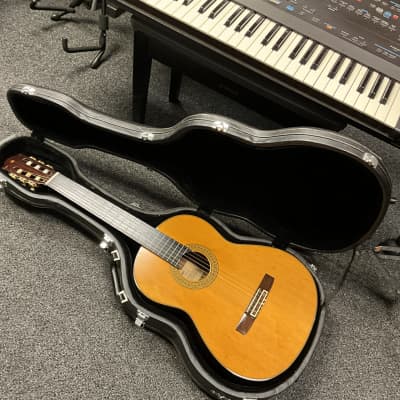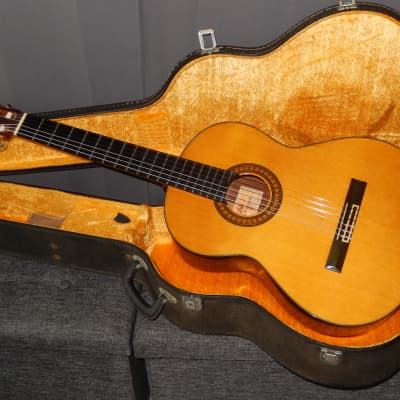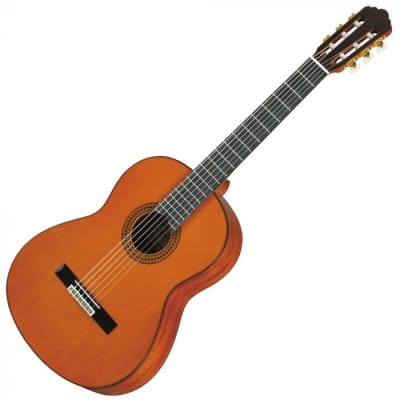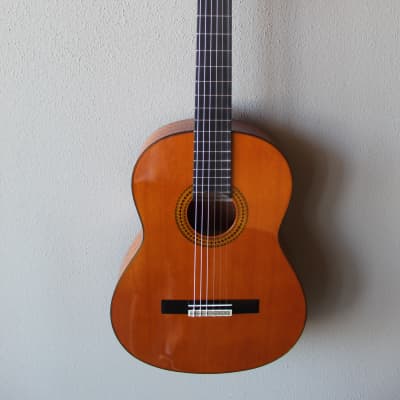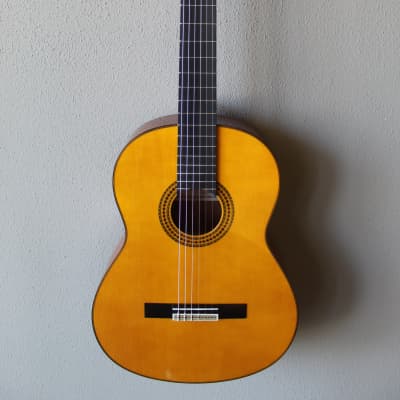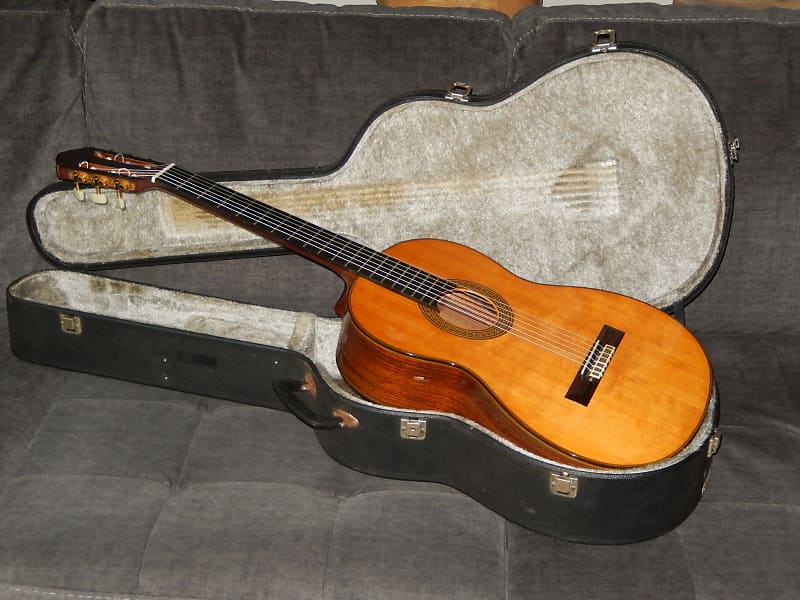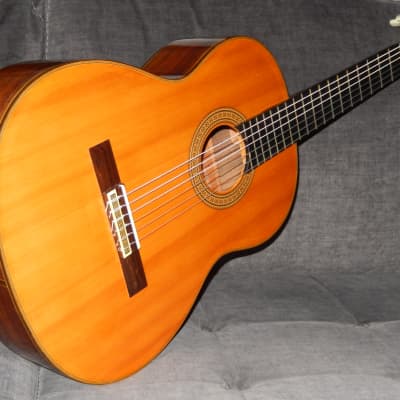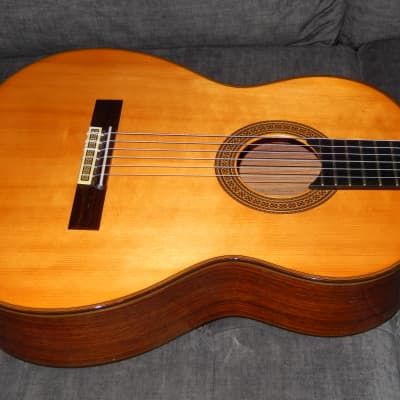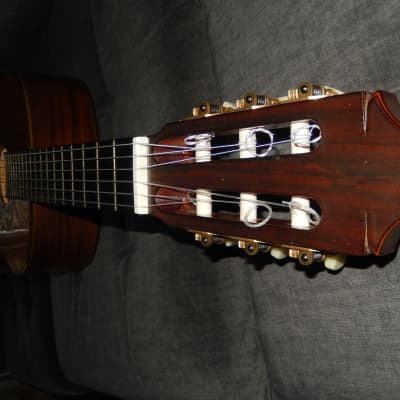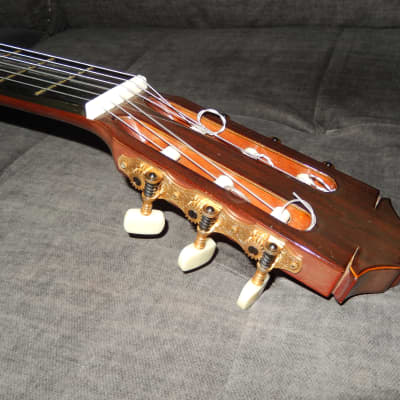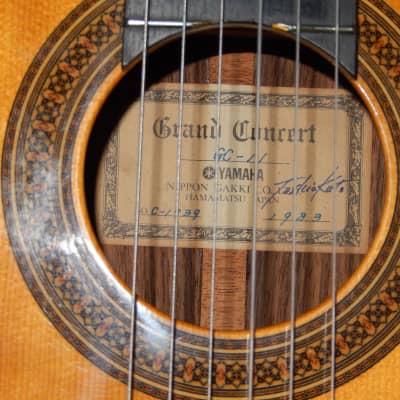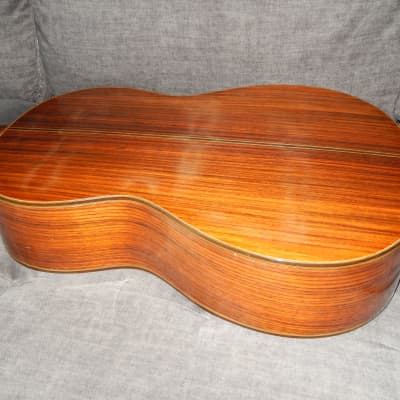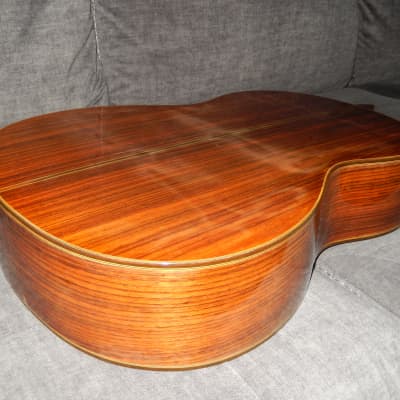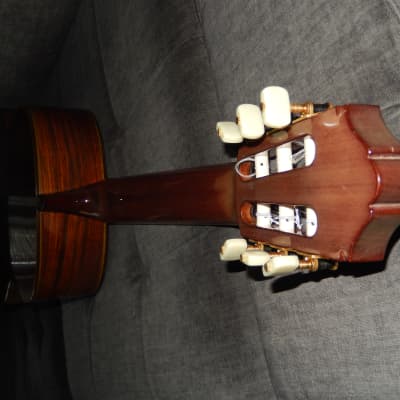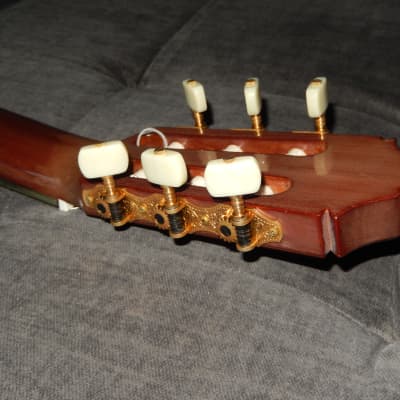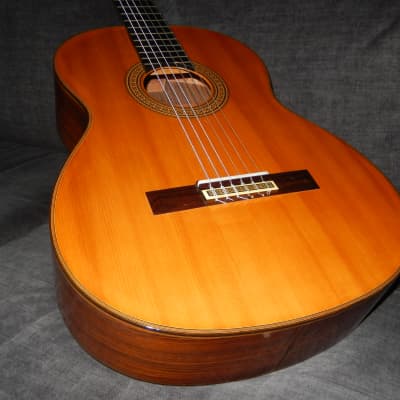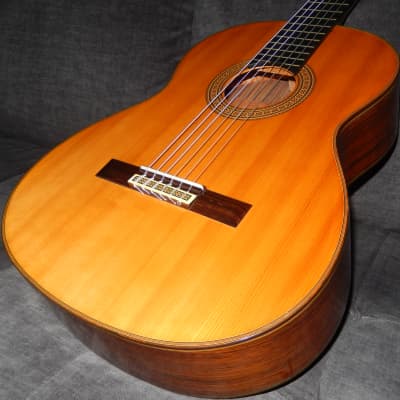Yamaha GRAND CONCERT GC11 1983
This Yamaha guitar was made in 1983 by Toshihiro Kato. It has practically the same specifications and is of the same grade as dicountinued model GC5 (made until 1982).
Toshihiro was not only the best luthier Yamaha Corporation ever had, but also one of the best luthiers Japan ever had. If Kato had his own workshop, he could easily outcompete Masaru Kohno or Sakazo Nakade (top elite Japanese luthiers of his era). Thanks to his incredible talents Yamaha's Grand Concert guitars were so highly prized by many international players, that Yamaha Co. could price them at the same level as Kohno was pricing his instruments. In fact, Yamaha guitars were often of much higher grade than similarly priced Kohno models.
Yamaha Co. didn't compete with Kohno by lowering prices of their guitars. Yamaha GC guitars simply offered more for the same price.
During early 1970s Japanese guitar makers were still trying hard to win as many international customers as possible. These were they years of significant international recognition of their, soon very highly regarded products. Yamaha was unquestioned leader among Japanese guitar exporters. Their guitars offered the highest possible level of craftsmanship with great deal of attention to even the tiniest details.
Yamaha started their fight for international clients in 1967 with new lineup of classical Grand Concert guitars made according to Spanish blueprints. They were: GC3 (solid Spruce top/ solid Indian Rosewood b/s) GC5, GC7 and GC10 (all 3 models with solid Spruce tops and solid Brazilian Rosewood b/s).
In 1968 Yamaha also introduced their lineup of great Grand Concert flamenco guitars. They were GC5F, GC7F and GC10F. The master luthier responsible for production of these guitars was Toshihiro Kato. He was helped by Hiroshi Harada, who was making classical models GC3 and GC5. Both these luthiers were trained by Eduardo Ferrer, a Spanish luthier from Granada, Spain who being invited (and appropriately rewarded) by Yamaha co., travelled to Japan during years 1964-1967.
It is very important to explain that 1960s and 1970s were years of very rapid devaluation of Japanese yen (hence rapid inflation of prices for all products). Because during those years practically all guitar models had some numbers closely related to their prices in yen, these models were quite frequently upgraded (relabeled) to higher numbers reflecting their higher prices.
For that reason, mentioned above Yamaha’s classical GC guitars lineup, was changed in 1971. New (1971-1973) lineup included models GC3D, GC6D, GC8D, GC10D (all 4 models made with solid Spruce tops & solid Indian Rosewood b/s) GC12D, GC15D and GC20D (all 3 models with solid Spruce tops & solid Brazilian Rosewood b/s). It is worth to mention that until 1974 all Yamaha classical GC models were made exclusively with Spruce tops.
In 1974 Yamaha’s classical GC guitar lineup was changed yet again. In that year, for the first time in its history, Yamaha decided to make classical guitars with cedar tops. This newly introduced GC classical guitar lineup included models: GC5M(S), GC7M(S), GC10M(S), GC15M(S), (all with Indian Rosewood b/s), GC20M(S), GC30A, GC30B (all with Brazilian Rosewood b/s). M=spruce. S=cedar, A=spruce, B=cedar
In mid 1970s Kato and Harada were joined by yet another great Yamaha luthier Hideyuki Ezaki.
In 1975 Kohno top models were 15, 20 and 30 (all with Brazilian Rosewood b/s). Model 30 was priced 300 000 yen just like Yamaha GC30A(B). In 1977 Kohno changed his lineup adding models 40 and 50 (both with improved looks but sounding no different than his earlier model 30) and changing specifications of model 15 from Brazilian Rosewood b/s to Indian Rosewood b/s. Yamaha's kept their lineup unchanged until 1979. In order to keep their prices at the same level, Yamaha GC guitars made in 1979 were made with somewhat lower grade woods, different finishes and less impressive ornamental extras if compared with those made in 1974. Production of GCM and GCS models ended by the end of 1979. Between years 1980-1985, Yamaha's lineup was being changed at least few times.
By late 1970s era of wonderful Japanese made instruments sold in the West at very affordable prices has ended.
In 1985 top models made at Yamaha's Hamamatsu workshop were GC70 and GC60 (similar specifications as GC30A from 1979), GC40 (the same specifications as GC20M from 1979), and GC30 (the same specifications as GC15M from 1979).
These top models became so expensive that they were beyond financial reach of great majority of domestic and international players. In order to supply high demand Yamaha’s luthiers have come up with beautifully sounding but more affordable models like GC11, GC16, GC21, GC26, GC31and so on. These models were made in Japan only between 1983-1987. In later years these models (with frequently changed specifications) were made by Yamaha’s Taiwanese workshop.
Toshihiro Kato retired from Yamaha Co. around 1986/87.
Among all Japanese made vintage guitars Yamahas made by Kato are the most Spanish sounding.
This truly great guitar offers great volume and response combined with very romantic tonality. Its trebles are crispy sweet, basses deep with great deal of overtones, yet relatively clean. All notes are well balanced, with great level of note clarity and separation, and great sustain.
It is certainly one of those guitars with “replacement value” much higher than its retail price at any given moment in time. If you’d like to buy similar grade brand new “hand made in Spain” guitar, you will have to spend at least $3000. Similar grade brand new instruments made by top Japanese luthiers are priced no less than $2000.
Despite its age, this guitar remains in overall very good structural and functional condition. While its body bears only few minor dents, scratches and rubbing marks, the most noticeable imperfection is intense cloudiness of finishes, especially visible against dark background, and very common on Yamaha guitars from that era. Being illuminated by strong camera's light, this cloudiness is greatly exaggerated on the pictures.
SPECIFICATIONS:
Top: Solid Spruce/7 braces fan/lacquer
Back & Sides: Indian Rosewood/urethane
Neck: Honduras Mahogany
Fingerboard: Ebony
String Length: 650mm
Nut width: 52 mm
Guitars action is set to 4.00 mm under E6 and 3.50 mm under E1 with extra room on the saddle.
Guitar will be shipped in used hard shell case in still usable condition.
Real Value of Japanese Vintage Guitars
The key to understand value of vintage Japanese guitars is to acknowledge galloping devaluation of Japanese yen in 1960s & 1970s. This devaluation was somewhat slower in 1980s. The best measure of this devaluation is Starting Yearly Salary of Japanese College Graduate (SYSJCG).
SYSJCG in in 1965 was 19 600 yen, in 1969 – 34 600 yen, in 1970 39 200 yen, in 1972 – 62 300 yen, in 1975 79 200 yen, in 1977 121 200 yen and in 1980 - 100 000 yen.
During 1960s and most of 1970s model numbers of Japanese guitars were strictly interconnected with their prices in Japanese yen. In late 1970s and during following decades model numbers were no longer strictly associated with their prices. Many Japanese guitar makers introduced model names instead of model numbers. Others were still using model numbers with addition of letter abbreviations or other symbols.
The best and only logical approach while evaluating real value (real grade) of vintage Japanese guitar is to compare its price in Japanese yen with SYSJCG during the year guitar was made.
Any guitar priced 100 000 in 1970 (labelled usually as No10) would be priced 200 000 yen in 1975 (relabeled to No20 or 2000), 300 000 yen in 1977 (labelled as No3, No30 or 3000). Starting in 1977 Masaru Kohno introduced his model No50 priced at 500 000 (skipping theoretical model 40). Soon other famous Japanese luthiers did the same. By 1983 Kohno started using model names instead numbers and was raising their prices as he was pleased. Naturally soon other Master luthiers did the same.
Knowing all of that, you can bet on that Masaru Kohno No50 made in 1982 is practically the same quality as Kohno No15 made in 1972, or Kohno no20 made in 1975 or Kohno No30 made in 1977. I know it for a fact.
The lowest grade models currently made by Matsuoka workshop are M75 and MH75. They are commonly considered as “beginner guitars”. Matsuoka model M30 made in 1973 is simply far, far better instrument. It is naturally better than model M50 made in 1977, model 80 made in 1982 or model M100 made in 1990. At present, the highest grade Matsuoka models are M300 and MH300. They absolutely stand no chance in competition with model M150 made in 1975… or model M200 made in 1977.
It is very important to mention that if modern era luthiers are using 40 years old woods to make a classical guitar, its price is at least $8000.

